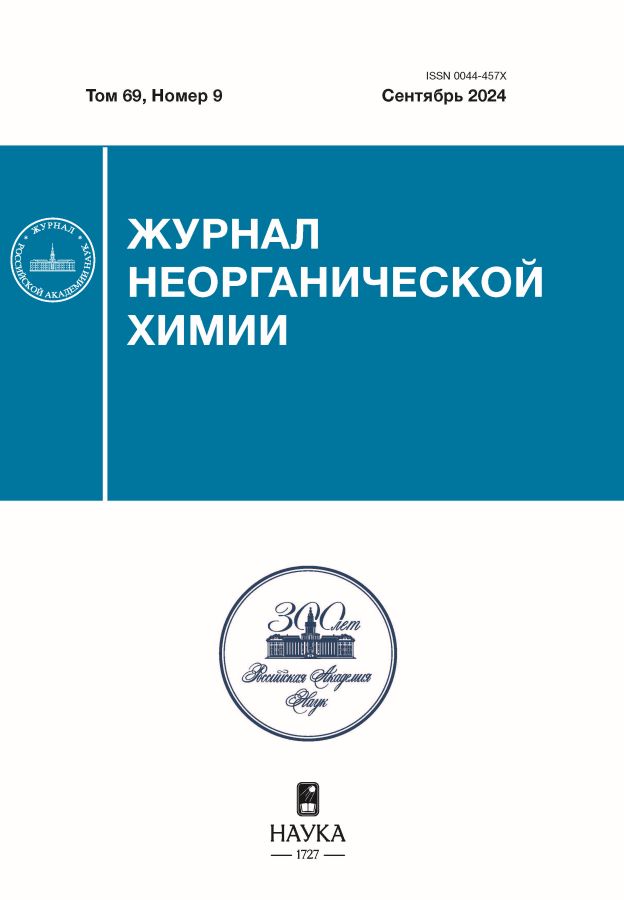Luminescence features of multicomponent cubic fluoride pyrochlores doped with europium ions
- Authors: Khaidukov N.M.1, Brekhovskikh М.N.1, Kirikova N.Y.2, Kondratyuk V.А.2, Makhov V.N.2
-
Affiliations:
- Kurnakov Institute of General and Inorganic Chemistry
- Lebedev Physical Institute
- Issue: Vol 69, No 9 (2024)
- Pages: 1254-1266
- Section: СИНТЕЗ И СВОЙСТВА НЕОРГАНИЧЕСКИХ СОЕДИНЕНИЙ
- URL: https://kazanmedjournal.ru/0044-457X/article/view/676623
- DOI: https://doi.org/10.31857/S0044457X24090057
- EDN: https://elibrary.ru/JSYFOA
- ID: 676623
Cite item
Abstract
Ceramic samples of multi-component fluorides Na3CaMg3AlF14 and NaCaMg2F7 doped with europium ions have been obtained by solid-phase synthesis. A comparison of the XRD patterns for the obtained compounds confirmed that a new polymorphic modification with a cubic pyrochlore structure has been obtained for Na3CaMg3AlF14 fluoride, which differs from the polymorph of this compound with a rhombohedral structure described in the literature. The addition of NH4(HF2) before the last annealing provided reducing conditions for the stabilization of europium ions exclusively in the 2+ charge state. Eu2+ ions in the synthesized fluoride matrices emit luminescence with a band peak at about 395 nm due to 4f 65d–4f 7 interconfiguration transitions. In these matrices the Eu2+ ions form predominantly one type of optical centers, which provides a fairly narrow band-width of 4f 65d–4f 7 luminescence ~30 nm. Also, in the synthesized ceramics Eu2+ ions emit narrow-line luminescence with a dominant line at ~362 nm, associated with 4f7–4f7 intraconfiguration transitions from the lowest excited state 6P7/2 to the ground state 8S7/2. The synthesized ceramics demonstrate good temperature stability of Eu2+ 4f 65d–4f 7 luminescence with thermal quenching temperature T1/2 equal to 504 and 543 K for Na3CaMg3AlF14:Eu2+ (1.0 at. %) and NaCaMg2F7:Eu2+ (0.5 at. %), respectively. This property may be of interest for the practical application of these phosphors. Additional annealing of ceramics in an argon atmosphere with the addition of NaHF2 instead of NH4(HF2) led to a partial conversion of europium ions from a divalent to a trivalent state. As a result, a series of narrow luminescence lines appears in the red region of the spectrum due to intraconfiguration transitions 4f 6–4f 6 (5D0 → 7FJ) in Eu3+ ions.
Keywords
Full Text
About the authors
N. M. Khaidukov
Kurnakov Institute of General and Inorganic Chemistry
Author for correspondence.
Email: mbrekh@igic.ras.ru
Russian Federation, Moscow, 119991
М. N. Brekhovskikh
Kurnakov Institute of General and Inorganic Chemistry
Email: mbrekh@igic.ras.ru
Russian Federation, Moscow, 119991
N. Yu. Kirikova
Lebedev Physical Institute
Email: mbrekh@igic.ras.ru
Russian Federation, Moscow, 119991
V. А. Kondratyuk
Lebedev Physical Institute
Email: mbrekh@igic.ras.ru
Russian Federation, Moscow, 119991
V. N. Makhov
Lebedev Physical Institute
Email: mbrekh@igic.ras.ru
Russian Federation, Moscow, 119991
References
- Fang M.-H., Leaño Jr.J.L., Liu R.-S. // ACS Energy Lett. 2018. V. 3. № 10. P. 2573. https://doi.org/10.1021/acsenergylett.8b01408
- Hariyani S., Sójka M., Setlur A., Brgoch J. // Nat. Rev. Mater. 2023. V. 8. № 11. P. 759. https://doi.org/10.1038/s41578-023-00605-6
- Liao H., Zhao M., Molokeev M.S. et al. // Angew. Chem. Int. Ed. 2018. V. 57. № 36. P. 11728. https://doi.org/10.1002/anie.201807087
- Liu R.S. // Chem. Mater. 2023. V. 35. № 16. P. 6179. https://doi.org/10.1021/acs.chemmater.3c01743
- Subramanian M.A., Aravamudan G., Subba Rao G.V. // Prog. Solid State Chem. 1983. V. 15. № 2. P. 55. https://doi.org/10.1016/0079-6786(83)90001-8
- Holliday K., Finkeldei S., Neumeier S. et al. // J. Nucl. Mater. 2013. V. 433. № 1–3. P. 479. https://dx.doi.org/10.1016/j.jnucmat.2012.10.028
- Garcia M.A.P., Gupta S.K., Mao Y. // J. Mol. Struct. 2020. V. 1220. P. 128688. https://doi.org/10.1016/j.molstruc.2020.128688
- Gupta S.K., Nigam S., Zuniga J.P., Mao Y. // Mater. Today Chem. 2022. V. 24. P. 100931. https://doi.org/10.1016/j.mtchem.2022.100931
- Berwal U., Singh V., Sharma R. // J. Lumin. 2023. V. 257. P. 119687. https://doi.org/10.1016/j.jlumin.2023.119687
- Sidey V. // Z. Kristallogr. 2017. V. 232. № 10. P. 729. https://doi.org/10.1515/zkri-2017-2057
- Khaidukov N.M., Brekhovskikh M.N., Kirikova N.Yu. et al. // J. Lumin. 2024. V. 272. P. 120646. https://doi.org/10.1016/j.jlumin.2024.120646
- Mumme W.G., Gray I.E., Birch W.D. et al. // Am. Mineral. 2010. V. 95. № 5-6. P. 736.
- Oliveira E.A., Guedes I., Ayala A.P. et al. // J. Solid State Chem. 2004. V. 177. № 8. P. 2943. https://doi.org/10.1016/j.jssc.2004.04.055
- Momma K., Izumi F. // J. Appl. Crystallogr. 2011. V. 44. № 6. P. 1272. https://doi.org/10.1107/S0021889811038970
- Shannon R.D. // Acta Crystallogr., Sect. A. 1976. V. 32. № 5. P. 751. https://doi.org/10.1107/S0567739476001551
- Ryan F.M., Lehmann W., Feldman D.W., Murphy J. // J. Electrochem. Soc. 1974. V. 121. № 11. P. 1475. https://doi.org/10.1149/1.2401714
- Henderson B., Imbusch G.F. Optical Spectroscopy of Inorganic Solids. Oxford: Clarendon Press, 1989.
- Adachi S. // ECS J. Solid State Sci. Technol. 2023. V. 12. № 1. P. 016002. https://doi.org/10.1149/2162-8777/acaeb9
- Meijerink A. // J. Lumin. 1993. V. 55. № 3. P. 125. https://doi.org/10.1016/0022-2313(93)90033-J
- Ellens A., Meijerink A., Blasse G. // J. Lumin. 1994. V. 59. № 5. P. 293. https://doi.org/10.1016/0022-2313(94)90056-6
- Wegh R.T., Meijerink A. // Phys. Rev. B. 1999. V. 60. № 15. P. 10820. https://doi.org/10.1103/PhysRevB.60.10820
- Kirm M., Stryganyuk G., Vielhauer S. et al. // Phys. Rev. B. 2007. V. 75. № 7. P. 075111. https://doi.org/10.1103/PhysRevB.75.075111
- Belsky A.N., Krupa J.C. // Displays. 1999. V. 19. № 4. P. 185. https://doi.org/10.1016/S0141-9382(98)00049-3
- Joos J.J., Seijo L., Barandiarán Z. // J. Phys. Chem. Lett. 2019 V. 10. № 7. P. 1581. https://doi.org/10.1021/acs.jpclett.9b00342
Supplementary files




















